GPU Passthrough w/ Radeon RX 6400
Installing the GPU
Ordered on Amazon for my hackintosh since it was cheap and seemed like it wasn’t going to be a risky fit in the MS-01.
The Easy Part
I decided to install an Radeon RX 6400 in one of the nodes to get a feel for how it’d perform, fit, and how hot it’d run. TODO update the hardware doc with the installation and link from here.
The Nightmare
Tne MAJOR thing I missed is the network adapters my proxmox node was relying on would have their names change after installing the GPU. This drove me crazy for a bit as I was looking for an MS-01 specific issue. Once I searched for “PROXMOX BROKE AFTER I DID A GPU THING” it was pretty clear a lot of folks didn’t realize this either…
To fix fine the new adapters:
ip link show
ip a
Then update /etc/network/interfaces to match the new names. For me I had to change a 2 to a 5 for my two SPF+ adapters.
Passing it Through
Configuring Proxmox to use the GPU
Next I had to configure proxmox so I could get at the GPU:
nano /etc/default/grub
Add intel_iommu=on like this GRUB_CMDLINE_LINUX_DEFAULT=”quiet intel_iommu=on”
update-grub
reboot
Still didn’t show up so I turned to official documentation which lead me to this command:
pvesh get /nodes/{nodename}/hardware/pci --pci-class-blacklist ""
Which gave me some relief since it was right in the list:
│ class │ device │ id │ iommugroup │ vendor │ device_name │ mdev │ subsystem_device │ subsystem_device_name
│ 0x030000 │ 0x743f │ 0000:03:00.0 │ 18 │ 0x1002 │ Navi 24 [Radeon RX 6400/6500 XT/6500M] │ │ 0x6405 │
Switching gears to this guide I added the modules:
Passthrough Modules
nano /etc/modules
Paste in:
vfio
vfio_iommu_type1
vfio_pci
vfio_virqfd
Then some wild west shit:
echo "options vfio_iommu_type1 allow_unsafe_interrupts=1" > /etc/modprobe.d/iommu_unsafe_interrupts.conf
echo "options kvm ignore_msrs=1" > /etc/modprobe.d/kvm.conf
Driver Blacklist
Then blacklist drivers so proxmox doesn’t mess with the GPU:
echo "blacklist amdgpu" >> /etc/modprobe.d/blacklist.conf
echo "blacklist radeon" >> /etc/modprobe.d/blacklist.conf
Others seem to be from nvidia
echo "blacklist nouveau" >> /etc/modprobe.d/blacklist.conf
echo "blacklist nvidia*" >> /etc/modprobe.d/blacklist.conf
Or intel:
echo "blacklist i915" >> /etc/modprobe.d/blacklist.conf
Add to VFIO
Then we add it to VFIO:
root@pve05:~# lspci -v | grep AMD
Yields:
03:00.0 VGA compatible controller: Advanced Micro Devices, Inc. [AMD/ATI] Navi 24 [Radeon RX 6400/6500 XT/6500M] (rev c7) (prog-if 00 ;
...
03:00.1 Audio device: Advanced Micro Devices, Inc. [AMD/ATI] Navi 21/23 HDMI/DP Audio Controller
Some more voodoo:
root@pve05:~# lspci -n -s 03:00
03:00.0 0300: 1002:743f (rev c7)
03:00.1 0403: 1002:ab28
GPU Vendor Code: 1002:743f Audio Bus Code: 1002:ab28
Now add the vendor codes to VFIO:
echo "options vfio-pci ids=1002:743f,1002:ab28 disable_vga=1"> /etc/modprobe.d/vfio.conf
Then update some shit:
update-initramfs -u
I think it needs a reboot after. The guide says to run reset which just clears the cmd.
Adding to MacOS VM
Seems too easy but this is what I came up with:

The hackintosh lost it’s shit at first but rebooted just fine after. You can tell adding the GPU has stressed it out.
No dice, going to see how the master did it.
nano /etc/pve/qemu-server/112.conf
hostpci0: 03:00,pcie=1,x-vga=on
Mine was missing x-vga=on and I needed vga: none instead of vmware.
Note I many need Host configuration later for the two GPU server…
Back to /etc/default/grub to add rootdelay=10
And some other stuff from the guide:
nano /etc/modprobe.d/kvm-intel.conf
# Nested VM support
options kvm-intel nested=1
nano /etc/modprobe.d/vfio-pci.conf
options vfio-pci ids=1002:743f,1002:ab28 disable_vga=1
# Note that adding disable_vga here will probably prevent guests from booting in SeaBIOS mode
Then:
update-grub
update-initramfs -k all -u
reboot
Still didn’t work.
PIVOT to Windows
The reddit guide walks through on windows and I can manage that a bit better to get my bearings.
For installing the VM I loosely followed these steps but the reddit guide (above) suggested I change a few things:
- Change
machine: pc-q35-8.1tomachine: q35 - Change
cpu: x86-64-v2-AEStocpu: host,hidden=1,flags=+pcid - Add
args: -cpu 'host,+kvm_pv_unhalt,+kvm_pv_eoi,hv_vendor_id=NV43FIX,kvm=off'
After going through the motions of installing Windows offline I was in. I set up nomachine and RDP so I could disable the virtual display in proxmox via Hardware -> Display -> None. After doing so nomachine no longer worked so I assume this relies on a display. RDP, however, not only worked but AMD’s driver software picked up the card no problem:
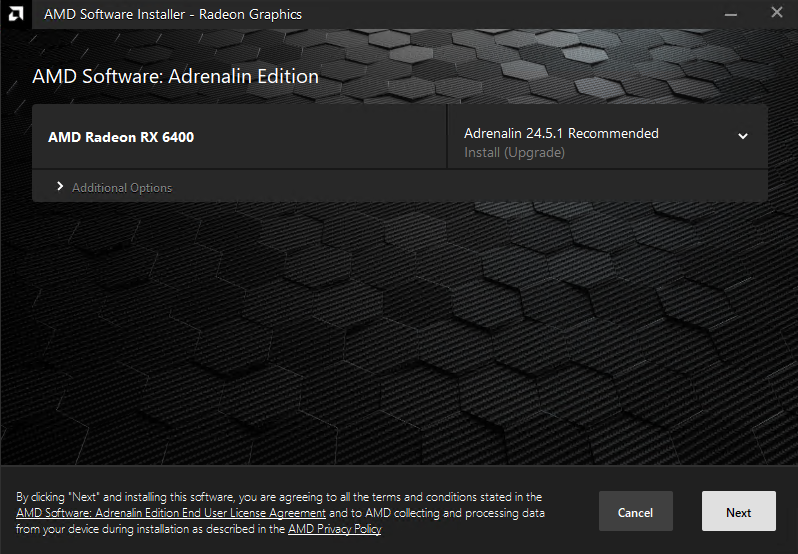
Even better, after installing the drivers nomachine worked again! And unlike RDP I wasn’t constrained to an upscaled resolution, I could crank this baby up to 4k!

However, this might be thanks to the dummy plug I stuck in when troubleshooting the macos VM.
Before going any further I activated windows using my a key from what use to be called MSDN. I then had a few years of updates to install.
Gaming
Since that was taking forever I decided to give a lightweight offline game a try. I use nomachine for everything and this is about the most responsive I’ve seen it.
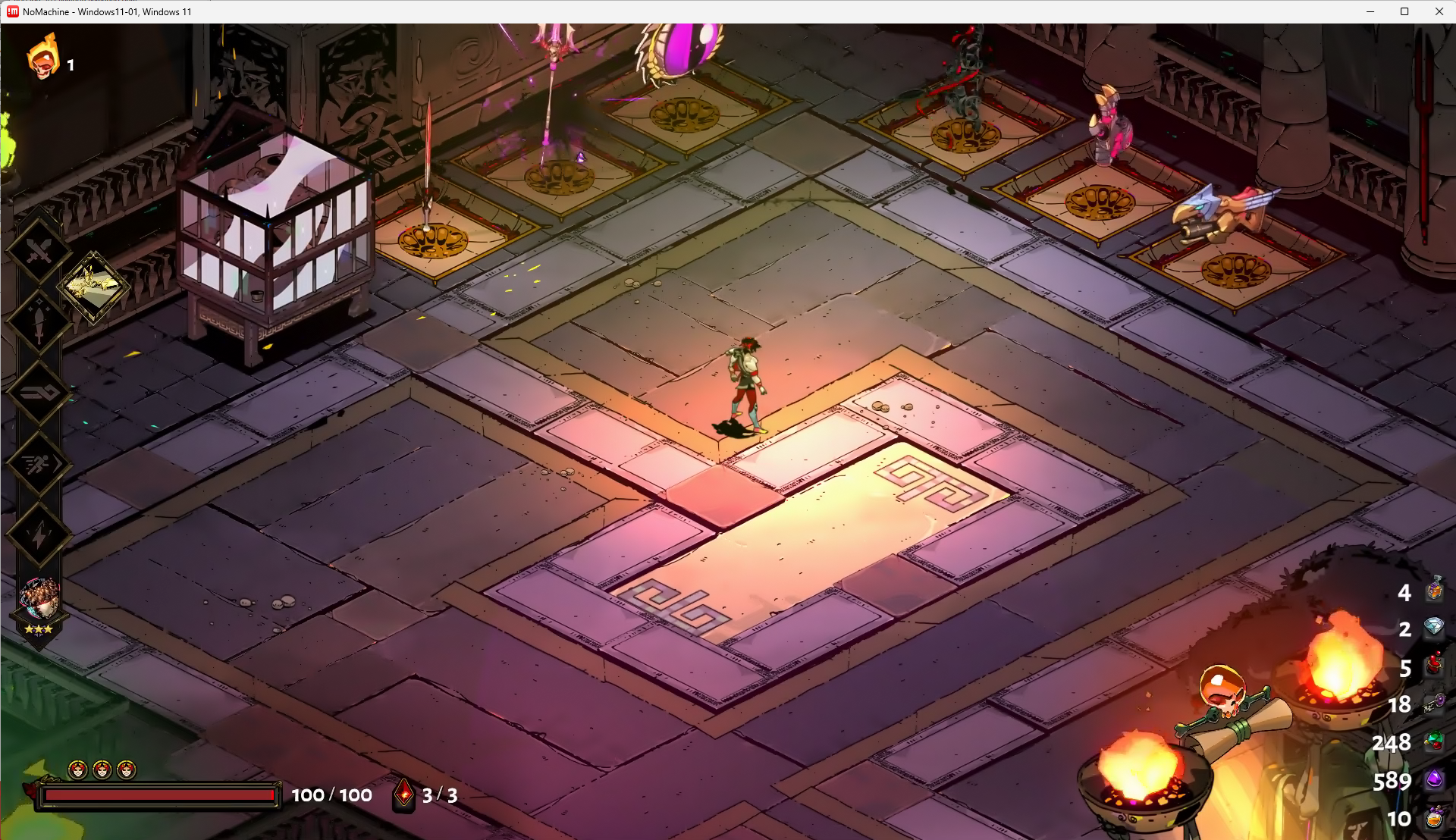
Now that’s just a 2D game so I wanted to really push it. For the final boss I chose…

TODO do this for windows
Well the final boss was playable but even on high settings I seemed to be missing textures:
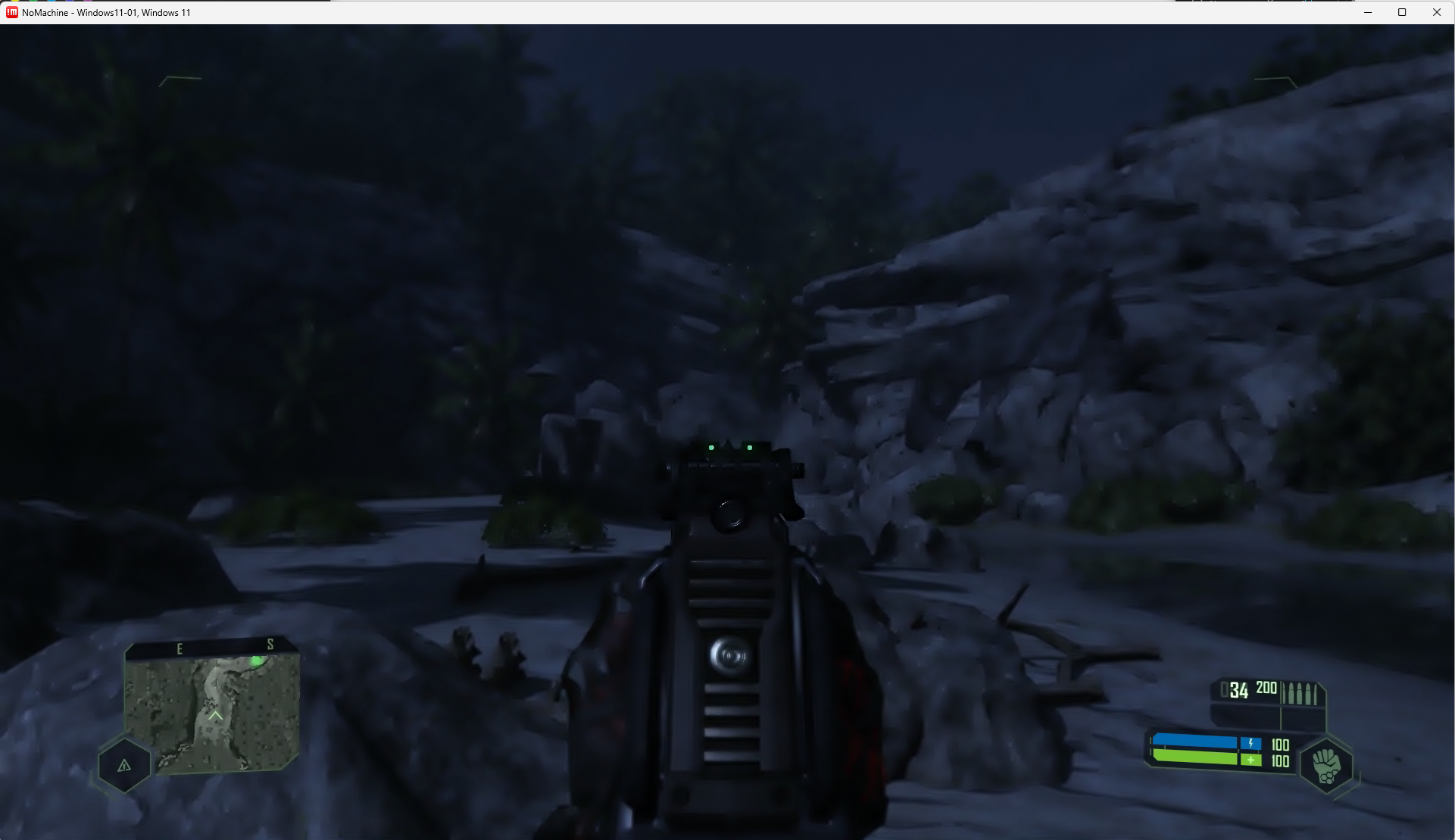
Enough distractions, time to go install some AMD drivers on a macos VM.
Benchmarks
After all this passing through I experimented a bit with a game. See the results over here.
Back to Mac!
It clicked when I went back. The mac VM isn’t booting because of the damn screen to select a disk. It was time to go back to config.plist.
Since the damn thing moves around and needs to be mounted every time I went ahead and followed these steps:
diskutil list
# Pick the EFI one
sudo mkdir /Volumes/EFI
sudo mount -t msdos /dev/disk1s1 /Volumes/EFI
A million XML elements away you’ll come to Misc/Boot/Timeout and then set the row below Timeout to a non zero value (I did 3 seconds). Now reboot and count to 3 and BAM we are in.
Now we can go back and turn off the display again!
This time I was able to ssh so at least I got past that:
manof@HaynesHyperion MINGW64 ~
$ ssh [email protected]
([email protected]) Password:
Last login: Tue Jun 11 00:46:25 2024
thaynes@mac02 ~ %
However, now nomachine can’t find a desktop (what desktop!)
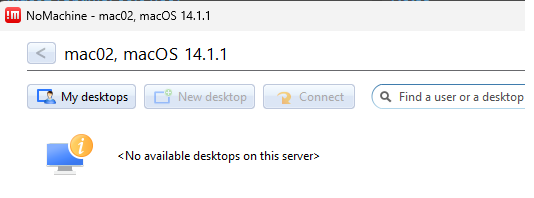
Going back to my VM config I’ll poke at a few more settings:
args: -device isa-applesmc,osk="ourhardworkbythesewordsguardedpleasedontsteal(c)AppleComputerInc" -smbios type=2 -device usb-kbd,bus=ehci.0,port=2 -global nec-usb-xhci.msi=off -global ICH9-LPC.acpi-pci-hotplug-with-bridge-support=off -cpu host,vendor=GenuineIntel,+invtsc,+hypervisor,kvm=on,vmware-cpuid-freq=on
balloon: 0
bios: ovmf
boot: order=virtio0;net0
cores: 8
cpu: x86-64-v2-AES
efidisk0: vm-disks:vm-112-disk-0,efitype=4m,pre-enrolled-keys=1,size=1M
hostpci0: 0000:03:00,pcie=1,x-vga=1
ide0: ISO-Templates:iso/macOS-Sonoma-14.1.1.iso,cache=unsafe,size=16000M
machine: q35
memory: 20480
meta: creation-qemu=8.1.5,ctime=1717904063
name: mac02
net0: vmxnet3=BC:24:11:A0:69:A4,bridge=vmbr0,firewall=1
numa: 0
ostype: other
scsihw: virtio-scsi-pci
smbios1: uuid=931fc13d-1caa-45e3-b042-472a907eb4fc
sockets: 1
vga: std,memory=512
virtio0: vm-disks:vm-112-disk-1,cache=unsafe,discard=on,iothread=1,size=256G
vmgenid: 89085a0f-8b1a-4de2-976e-edd86c9b0d09
I changed cpu to cpu: host,hidden=1,flags=+pcid
Add args: -cpu '...+kvm_pv_unhalt,+kvm_pv_eoi,kvm=off' (kvm=on was set before)
Here’s what Nick man had:
args: -device isa-applesmc,osk="..." -smbios type=2 cpu host,kvm=on,vendor=GenuineIntel,+kvm_pv_unhalt,+kvm_pv_eoi,+hypervisor,+invtsc,+pdpe1gb,check -smp 32,sockets=2,cores=8,threads=2 -device 'pcie-root-port,id=ich9-pcie-port-6,addr=10.1,x-speed=16,x-width=32,multifunction=on,bus=pcie.0,port=6,chassis=6' -device 'vfio-pci,host=0000:0a:00.0,id=hostpci5,bus=ich9-pcie-port-6,addr=0x0,x-pci-device-id=0x10f6,x-pci-sub-vendor-id=0x0000,x-pci-sub-device-id=0x0000' -global ICH9-LPC.acpi-pci-hotplug-with-bridge-support=off
But still no dice. My main suspicion was that I’ve been following guides for people who plug their peripherals right into the devices passed the the VM. But then I found this and I learned that the RX 6400 didn’t cut the mustard. I did what any reasonable human being would do and bought an RX 6800 but that’ll have to wait for the MEGA AI SERVER.
Ubuntu Passthrough
Figuring it Out
Not as many guides exists for this as the general “pass through shit” ones but this looks sufficiently dangerous. My VM is was missing a good chunk of what this had though.
- Machine was
Dafaultinstead ofq35 - BIOS was
Default (SeaBIOS)instead ofOVMFand because of this I had noEFI Disk
I set that all up and added the GPU as a PCIE device. The VM instantly migrated to a different node which made 0 sense. It then wouldn’t migrate back because it had a local resource attached that couldn’t be found. Nothing is ever easy.
To rule out the two differences I decided to go without the GPU first. It still migrated and wouldn’t start, but on the host it migrated to is started. Then it migrated back and started again. Maybe I’ll remove this one from HA for now…
This reminded me of another VM I tried to switch the BIOS type on after creation. I ended up nuking that one, not sure how to get the EFI Disk working after the fact. Maybe SeaBIOS is fine.
Somehow the display for VNC was “Portrait (Right)” which I think was my fault from an earlier experiment. After much inverted mouse navigation I got it back and shut down to add the GPU.
This program shows some stuff about the computer but nothing for the GPU:
sudo lshw-gtk
This works:
lspci -v -s $(lspci | grep ' VGA ' | cut -d" " -f 1)
Not there yet, gonna see if I can switch the BIOS. I guess here the trick is to create a new VM and then us it’s EIF Diskbut maybe if I am clever I can clone it.
The new disk was efidisk0: vm-disks:vm-115-disk-0,efitype=4m,pre-enrolled-keys=1,size=1M
And the old was efidisk0: vm-disks:vm-110-disk-2,efitype=4m,pre-enrolled-keys=1,size=1M
So I just needed to swap the.. but it didn’t work so I guess onto the fresh install for now!
Trying Again
After much fiddling with the new VM I landed with these settings:
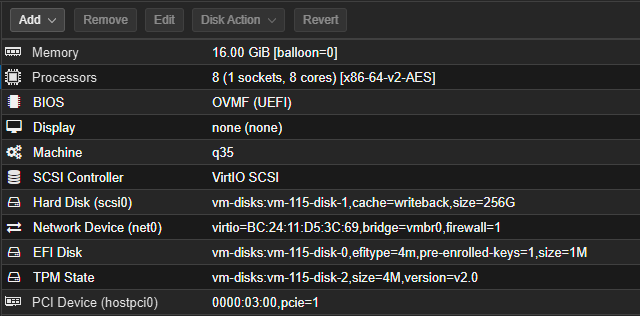
And boom we got a GPU:
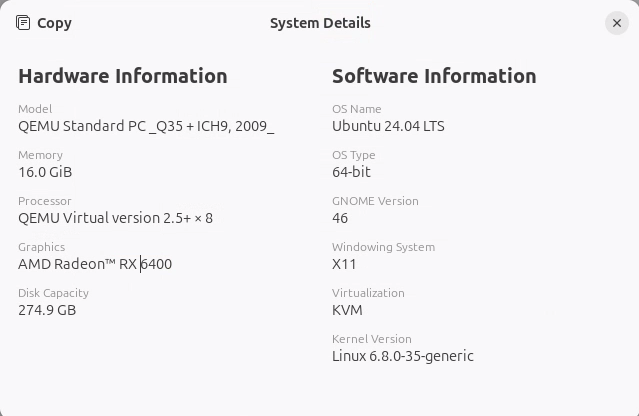
However something seemed to break in the fiddling so I may need one more…
RX 570
I did some dirty deeds to connect this to the MS-01 which I will post later. Once it was running I was able to map it as a PCIe passthrough for both Widows 11 and MacOS. I didn’t seem to need a rom file despite not being able to set the iGPU as the primary boot option in BIOS with it installed as with it installed BIOS was just a blank screen.
For windows I could get output from the VM direct from the GPU and pass through the USB ports to use it just like a baremetal install. However, I’d get Error 43 in Device Manager so something wasn’t right.
For mac I could get the GPU through but the monitor would get stuck on the loading bar while nomachine let me log in and see that it was passed through:
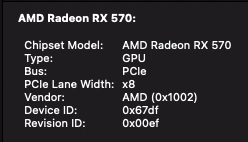
Adding things the iGPU steps didn’t
This node was setup for IOMMU for the iGPU so I was going to try and edit some stuff to see if I could resolve these problems:
Taken from above:
root@pve04:~# echo "options vfio_iommu_type1 allow_unsafe_interrupts=1" > /etc/modprobe.d/iommu_unsafe_interrupts.conf
root@pve04:~# echo "options kvm ignore_msrs=1" > /etc/modprobe.d/kvm.conf
root@pve04:~# echo "blacklist amdgpu" >> /etc/modprobe.d/blacklist.conf
root@pve04:~# echo "blacklist radeon" >> /etc/modprobe.d/blacklist.conf
root@pve04:~# echo "blacklist nouveau" >> /etc/modprobe.d/blacklist.conf
root@pve04:~# echo "blacklist nvidia*" >> /etc/modprobe.d/blacklist.conf
root@pve04:~# echo "blacklist i915" >> /etc/modprobe.d/blacklist.conf
This file was missing:
nano /etc/modprobe.d/kvm-intel.conf
# Nested VM support
options kvm-intel nested=1
Then /etc/modprobe.d/vfio-pci.conf needed the codes..
root@pve04:~# lspci -n -s 01:00
01:00.0 0300: 1002:67df (rev ef)
01:00.1 0403: 1002:aaf0
Then bring em in
nano /etc/modprobe.d/vfio-pci.conf
options vfio-pci ids=1002:67df,1002:aaf0 disable_vga=1
# Note that adding disable_vga here will probably prevent guests from booting in SeaBIOS mode
Then apply all those changes:
update-grub
update-initramfs -k all -u
reboot
I think the iGPU stuff is conflicting so I’m going to simplify GRUB
nano /etc/default/grub
First going back from:
GRUB_DEFAULT="gnulinux-advanced-8b2eb4ef-3076-4676-9210-df8d2ae81f5e>gnulinux-6.5.13-3-pve-advanced-8b2eb4ef-3076-4676-9210-df8d2ae81f5e"
To:
GRUB_DEFAULT=0
But I will leave the iGPU stuff commented out if I want to use it again. Then from:
GRUB_CMDLINE_LINUX_DEFAULT="quiet intel_iommu=on iommu=pt i915.enable_guc=3 i915.max_vfs=7 rootdelay=10"
To:
GRUB_CMDLINE_LINUX_DEFAULT="quiet intel_iommu=on rootdelay=10"
Then apply the changes:
update-grub
shutdown -r now
WARNING every time the kernal changes the network interfaces get messed up
RX 6800
Ended up hooking this to the MS-01…
Configuring
Find PCI Device:
lspci -v -s $(lspci | grep ' VGA ' | cut -d" " -f 1)
Find IDs for vfio-pci.conf
root@pve04:~# lspci -n -s 03:00
03:00.0 0300: 1002:73bf (rev c3)
03:00.1 0403: 1002:ab28
nano /etc/modprobe.d/vfio-pci.conf
options vfio-pci ids=1002:73bf,1002:ab28 disable_vga=1
# Note that adding disable_vga here will probably prevent guests from booting in SeaBIOS mode
Then apply changes (no idea which is really needed)
update-grub
update-initramfs -k all -u
reboot
Reset Bug
Trying this too:
apt install pve-headers-$(uname -r)
apt install git dkms build-essential
git clone https://github.com/gnif/vendor-reset.git
cd vendor-reset
dkms install .
echo "vendor-reset" >> /etc/modules
update-initramfs -u
shutdown -r now
This guy says to put
vendor-resetat the top of the modules!
And This guy says you need a script and the first guy agrees!
Need to run this command:
echo 'device_specific' > /sys/bus/pci/devices/0000\:03\:00.0/reset_method
- Add to script here
/var/lib/vz/gpu-vendor-reset-method.sh - Add the codeblock below to
/etc/systemd/system/gpu-vendor-reset-method.service
[Unit]
Description=Set the AMD GPU reset method to 'device_specific'
After=default.target
[Service]
ExecStart=/bin/bash /var/lib/vz/gpu-vendor-reset-method.sh
[Install]
WantedBy=default.target
- Activate it with
systemctl enable gpu-vendor-reset-method.service - Reboot
- Check
systemctl status gpu-vendor-reset-method.service
Check with dmesg | grep vendor_reset
Wrong Kernal Making Life Hard
Minor problem noticed rebooting - it’s stil booting into the wrong Kernal and my interfaces get out of wack
I want: Linux 6.8.4-3-pve (2024-05-02T11:55Z) whish should be the 0 index but it’s not working: grep menu /boot/grub/grub.cfg WIll try setting
GRUB_DEFAULT="gnulinux-advanced-8b2eb4ef-3076-4676-9210-df8d2ae81f5e>gnulinux-6.8.4-3-pve-advanced-8b2eb4ef-3076-4676-9210-df8d2ae81f5e"in/etc/default/grubinstead. Didn’t work I will tryproxmox-boot-tool kernel pin 6.8.4-3-pve
I think pin was the ticket as I got:
root@pve04:~# proxmox-boot-tool kernel pin 6.8.4-3-pve
Overriding previously pinned version '6.5.13-3-pve' with '6.8.4-3-pve'
Setting '6.8.4-3-pve' as grub default entry and running update-grub.
Now I will move along and see if I can fix the reset bug:
Check with dmesg | grep vendor_reset -> works on latest kernal
I think this is triggered when I fiddle with the drivers on windows, better safe than sorry.
AMD Adrenaline DRV64 Error 1723
After setting the RX 6800 as the primary GPU is passes through to Windows no problem but AMD drivers are not great.
Bunch of errors pop up and installation fails with “DRV64 Error 1723”. Googling says to clean out the AMD drivers with ccleaner and try clean. However, after rebooting on the uninstall I’m back to Error 43. Could be the reset shit, worth a shot re-installing that given on the Kernal nonsense and rebooting.
Worst case here’s a mega hack to try…
/root/fix_gpu_pass.sh
#!/bin/bash
echo 1 > /sys/bus/pci/devices/0000\:01\:00.0/remove
echo 1 > /sys/bus/pci/rescan
Then create a cron job w/ the script:
@reboot /root/fix_gpu_pass.sh
But gonna go back to the old one and save this for the weekend.
RX 570
root@pve04:~# lspci -n -s 01:00 01:00.0 0300: 1002:67df (rev ef) 01:00.1 0403: 1002:aaf0
nano /etc/modprobe.d/vfio-pci.conf
options vfio-pci ids=1002:67df,1002:aaf0 disable_vga=1
Note that adding disable_vga here will probably prevent guests from booting in SeaBIOS mode
I couldn’t get my iGPU Windows VM to not error 43 on the 570 but a fresh Windows VM worked fine after windows updates.